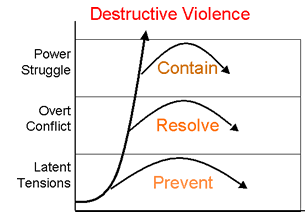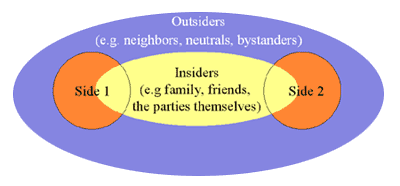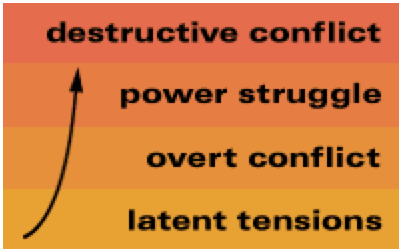Recursos por Rol del Tercer Lado
El Proveedor – Permitiendo a las personas cubrir sus necesidades
Sitios útiles:
- The Giraffe Project
- Grameen Bank (Mohammed Yunus)
- Mauritius
- Conflict Resolution Info and the Role of the Provider
Bibliografía breve:
- Bornstein, D. (1997). The Price of a Dream: The Story of The Grameen Bank. Chicago: University of Chicago Press.
- Burton, J. (1990). Conflict: Human Needs Theory. New York: St. Martin’s Press.
- Gurr, T. (1970). Why Men Rebel. Boulder: Westview Press.
- Dollard, J., L. Doob, N.E. Miller, O.H. Mowrer, and R.R. Sears. (1939). Frustration and Aggression. New Haven: Yale University Press.
- Maslow, A. (1987). Motivation and Personality (Third Edition). New York: Harper and Row.
- Ury, William (2000). The Third Side:Why We Fight and How We Can Stop. New York: Penguin.
- Ury, William (2001). Must We Fight?: From the Battlefield to the Schoolyard — A New Perspective on Violent Conflict and Its Prevention. New York: John Wiley & Sons.
El Maestro – Dando a las personas las habilidades para manejar el conflicto
Sitios útiles:
- Conflict Resolution Resource Center
- Educators For Social Responsibilities
- The School for Conflict Analysis and Resolution at George Mason University
- National Coalition Building Institute
- International MultiCultural Institute
- Program on Negotiation at Harvard Law School
- United States Institute of Peace
- University of Colorado Conflict Research Consortium – Education and peace lessons publications
- The Hague Appeal for Peace – focuses on peace and disarmament
- Peace Education Foundation
- Consensus Building Institute
Bibliografía breve:
- Bodine, R. and D. Crawford (1997). The Handbook on Conflict Resolution Education: A Guide to Building Quality Programs in Schools. San Francisco: Jossey Bass.
- Girard, J. and S. Koch (1996). Conflict Resolution in the Schools: A Manual for Educators. San Francisco: Jossey Bass.
- Godine, R. (1994). Creating the Peaceable School: A comprehensive Program for Teaching Conflict Resolution. Research Press.
- Landry, E., D. Kolb, and J. Rubin (1991). Curriculum for Negotiation and Conflict Management. Cambridge, MA: PON Books.
- Ury, William (2000). The Third Side:Why We Fight and How We Can Stop. New York: Penguin.
- Ury, William (2001). Must We Fight?: From the Battlefield to the Schoolyard — A New Perspective on Violent Conflict and Its Prevention. New York: John Wiley & Sons.
El Constructor de Puentes – Estableciendo relaciones a través de las líneas de conflicto
Sitios útiles:
- The Center for the Common Good
- European Platform for Conflict Prevention and Transformation
- The Giraffe Project
- The Online Healthy Relationships Project
- PeaceBuilders
- Search for Common Ground
Bibliografía breve:
- Kelman, H. (1992). “Informal Mediation by the Scholar/Practitioner.” In Bercovitch, J. and J. Rubin, eds. Mediation in International Relations. New York: St. Martin’s Press. PP. 64-96.
- Kelman, H.C. (1993). “Coalitions across Conflict Lines: The Interplay of Conflicts within and between the Israeli and Palestinian Communities.” In Worshel S. and J. Simpson, eds. Conflict between People and Groups. Chicago: Nelson-Hall.
- Ury, William (2000). The Third Side:Why We Fight and How We Can Stop. New York: Penguin.
- Ury, William (2001). Must We Fight?: From the Battlefield to the Schoolyard — A New Perspective on Violent Conflict and Its Prevention. New York: John Wiley & Sons.
El Mediador – Reconciliando intereses en conflicto
Sitios útiles:
- ADR Resources
- Colorado Mediators & Arbitrators
- Federal Mediation and Conciliation Services
- National Association for Community Mediation
- School Mediation Associates
Bibliografía breve:
- Beer, J. and E. Stief. (1997) Mediator’s Handbook Third Edition. New Society Publishing.
- Bush, B. and J. Folger. (1994) The promise of mediation: Responding to conflict through empowerment and recognition. San Francisco: Jossey Bass.
- Moore, Christopher. (1996) The Mediation Process: Practical Strategies for Resolving Conflict Second Edition. San Francisco: Jossey Bass.
- Ury, William (2000). The Third Side:Why We Fight and How We Can Stop. New York: Penguin.
- Ury, William (2001). Must We Fight?: From the Battlefield to the Schoolyard — A New Perspective on Violent Conflict and Its Prevention. New York: John Wiley & Sons.
El Arbitro – Determinando Derechos en Disputa
Sitios útiles:
- American Arbitration Association
- Colorado Mediators & Arbitrators
- Center for Court Innovation
- International Council for Commercial Arbitration
- International Arbitration Database
Bibliografía breve:
- Elkouri, F., E. Elkouri, M. Volz, E. Goggin. (1997) How Arbitration Works: Elkouri and Elkouri Fifth Edition. BNA Books.
- Goldberg, S., F. Sander, and N. Rogers (1992) Dispute Resolution: Negotiation, Mediation, and Other ProcessesSecond Edition. Boston: Little Brown.
- Goodman, A. (1993) Basic Skills for the New Arbitrator Solomon Publications.
- Ury, William (2000). The Third Side:Why We Fight and How We Can Stop. New York: Penguin.
- Ury, William (2001). Must We Fight?: From the Battlefield to the Schoolyard — A New Perspective on Violent Conflict and Its Prevention. New York: John Wiley & Sons.
El Equilibrador – Democratizando el Poder
Sitios útiles:
- The Albert Einstein Institution (for Nonviolent Struggle)
- Group of 77 (Developing Nations Organization)
- M.K. Gandhi Institute for Nonviolence
- The National Democratic Institute
- OneWorld International Network
- US Equality Opportunity Commission (Dispute Resolution Services)
- A Force More Powerful
Bibliografía breve:
- Ackerman, P. and C. Kruegler. (199). Strategic Nonviolent Conflict: The Dynamics of People Power in the Twentieth Century. New York: Praeger.
- King, Jr. M.L. (1958) Stride Toward Freedom: The Montgomery Story. New York: Harper & Brothers.
- Laue, J. and G. Cormick. (1978). “The Ethics of Intervention in Community Disputes.” In ed. Bermant, G., H. Kelman and D. Warwick, The Ethics of Social Intervention. Washington, DC: Halsted Press, PP. 205-232.
- Gandhi, M. (1983). Autobiography: The Story of My Experiments with Truth. Dover Publishers.
- Sharp, G. (1973). The Politics of Nonviolent Action Volumes 1, 2, and 3. Boston: Porter Sargent Publishers.
- Ury, William (2000). The Third Side:Why We Fight and How We Can Stop. New York: Penguin.
- Ury, William (2001). Must We Fight?: From the Battlefield to the Schoolyard — A New Perspective on Violent Conflict and Its Prevention. New York: John Wiley & Sons.
- Volkan, V. (1988). The Need to Have Enemies and Allies: From Clinical Practice to International Relationships.Northvale, NJ: Jason Aronson.
El Sanador – Reparando Relaciones Dañadas
Sitios útiles:
- Bruderhof Forgiveness Guide
- South Africa’s Truth and Reconciliation Commission
- Trauma Research Net
- Victim Offender Reconciliation Program Information and Resource Center
Bibliografía breve:
- Washington, R. and G. Kehrein. (1996). Breaking Down Walls : A Model for Reconciliation in an Age of Racial Strife.Moody Press.
- Menkin, E.S. and L. Baker. “I Forgave My Sister’s Killer: I couldn’t begin to heal until I let go of my hatred.” Ladies’ Home Journal, December 1995.
- Price, M. “Victim-Offender Mediation: The State of the Art.” VOMA Quarterly Volume 7, Number 3: Fall-Winter 1996.
- Ury, William (2000). The Third Side:Why We Fight and How We Can Stop. New York: Penguin.
- Ury, William (2001). Must We Fight?: From the Battlefield to the Schoolyard — A New Perspective on Violent Conflict and Its Prevention. New York: John Wiley & Sons.
- Volkan, V. and Zintl, E. (1993). Life After Loss: Lessons of Grief. New York: Charles Scribner’s Sons.
El Testigo: Prestar atención a la escalada
Sitios útiles:
- Amnesty International
- Early Warning, Timely Response: A Guide to Safe Schools
- The Guardian Angels
- Human Rights Internet
- Human Rights Watch
- International Human Rights Law Group
- M.K. Gandhi Institute for Nonviolence
- UN Watch
- Witnesses
- Witness for Peace
Bibliografía breve:
- Barnett, V. (1999). Bystanders Conscience and Complicity During the Holocaust. Greenwood Press. Westport, Conn. 1999.
- Staub, E. (1997). “Preventing Genocide: The Power of ‘Bystanders'”. Boston Research Center for the 21st Century Newsletter #9.
- Staub, E. (1998). “Bystander Psychology: Studying the pivotal role of bystanders.” Deathly Silence Guide.
- Ury, William (2000). The Third Side:Why We Fight and How We Can Stop. New York: Penguin.
- Ury, William (2001). Must We Fight?: From the Battlefield to the Schoolyard — A New Perspective on Violent Conflict and Its Prevention. New York: John Wiley & Sons.
El Referee – Estableciendo Límites para la Lucha
Sitios útiles:
Bibliografía breve:
- Mindell, A. (1995). Sitting in the Fire: Large Group Transformation Using Conflict and Diversity. Lao Tse Press.
- Schmidt, F. and A. Friedman. (1989). Fighting Fair for Families. Peace Education Foundation.
- Sharp, G. (1990). Civilian-Based Defense. Princeton: Princeton University Press.
- Ury, William (2000). The Third Side:Why We Fight and How We Can Stop. New York: Penguin.
- Ury, William (2001). Must We Fight?: From the Battlefield to the Schoolyard — A New Perspective on Violent Conflict and Its Prevention. New York: John Wiley & Sons.
El Guardián de la Paz – proveyendo protección
Sitios útiles:
Bibliografía breve:
- Otunnu, O., M. Doyle, Eds. (1998). Peacemaking and Peacekeeping for the New Century. New York: Rowman and Littlefield.
- Shusta, R., D. Levine, and P. Harris. (1994). Multicultural Law Enforcement: Strategies for Peacekeeping in a Diverse Society. Prentice Hall.
- Ury, William (2000). The Third Side:Why We Fight and How We Can Stop. New York: Penguin.
- Ury, William (2001). Must We Fight?: From the Battlefield to the Schoolyard — A New Perspective on Violent Conflict and Its Prevention. New York: John Wiley & Sons.
- Weber, T. and E. Boulding. (1996). Gandhi’s Peace Army : The Shanti Sena and Unarmed Peacekeeping. Syracuse: Syracuse University Press.




